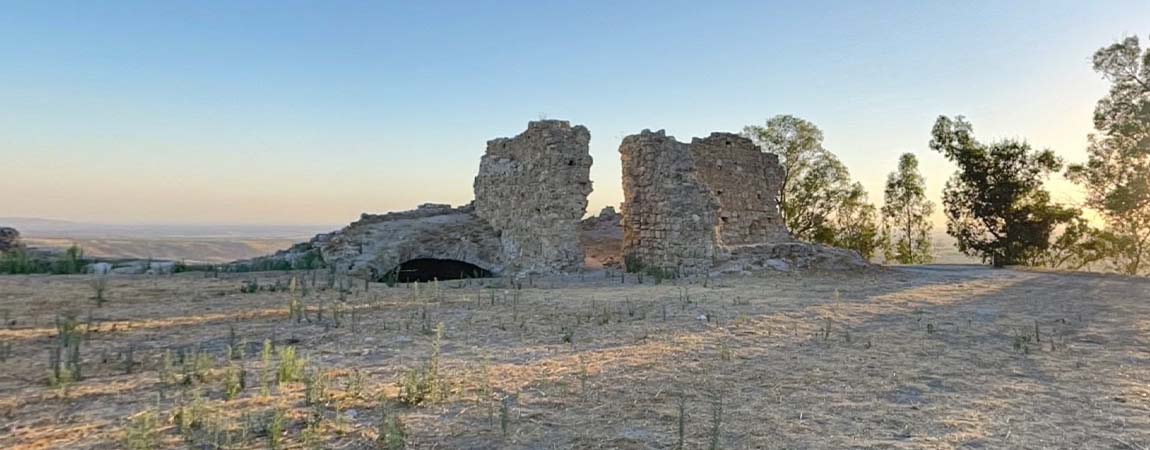
The ruins of a castle alone constitute a fascinating and mysterious setting. If then, beneath it, you discover tunnels that wind underground, the charm increases, arousing the curiosity of visitors and scholars and history enthusiasts.
That's what happens to the Castle of Santapau of Licodia Eubea, erected in 1274. Some say that the castle was used as a fortress under Arab and Norman domination. The earthquake of 1693 destroyed it completely, leaving only a few watchtowers, a few internal walls and its bases intact.
Today, visiting the ruins of the Castle, one can still imagine how incredible and lively the life that took place there was.
Notes on Licodia Euboea
Licodia Eubea, in the province of Catania, is a tiny village with an ancient and interesting history, full of wonderful cultural attractions. Its foundation is rather uncertain, but many of the archaeological finds found in the area identify it the current village with the ancient Euboialegendary town founded by the Chalcis in 650 BC
Its name has composite origins: Euboea would derive from the name of the colony of Calcidesi which has already been mentioned, while Licodia (from the Arabic Al Quds which means rugged cliff) derives from the name of the feudal village founded in the Middle Ages.
Architectural heritage of Licodia Eubea
In addition to Santapau Castle, Licodia Eubea boasts several valuable religious buildings both from a historical and architectural point of view.
Worth mentioning are: the Church of Bianchetto, built in the eighteenth century with an octagonal plan, considered one of the best preserved examples of Sacred Architecture in the area; the Church of Santa Lucia, located in the Borgo district, built in the 14th century, which includes impressive works of art created by some local artists; there Church and Convent of the Capuchins, erected in 1568, dedicated to St. Mary of the Angels which houses a wonderful cloister enriched by impressive decorations dating back to the seventeenth century; there Church of Carmine, built in 1563 by the marquise Antonia del Balzo, destroyed by a violent earthquake and completely restructured in 1930 with the addition of a new bell tower; there Church of Santa Margherita, built in the seventeenth century, full of stuccos and incredible frescoes.
Near the village it is possible to visit the ancient ones Caves of Marineo dating back to the Neolithic period (5000-4300 BC).
Santapau Castle
Licodia Eubea is placed on the top of the Iblei Mountains, in the southeast of Sicily. At the top of the hill that bears its name (Castle Hill), near the town, stands the castle of which today we can see only a few remains that survived the tragic earthquake of 1693 which destroyed a large part of the Val di Noto.
Millennia of history are buried under the ground on which the castle once stood, the traces of which have been revealed by numerous archaeological excavations. The oldest finds date back to four thousand years ago, at theBronze Age.
The first news referring to the castle of Licodia Eubea dates back to 1274. It is hypothesized that it was built much earlier, perhaps already in the Byzantine era, as can be guessed from the remains that recall the architecture of the Roman empire of the late age. The original building was presumably subject to violent attacks by Arab rulers who destroyed it.
Later, the Angevins rebuilt it and from that moment it was called Castrum Licodiae. The ownership of the castle passed over the centuries to various families. Among them, the Santa Paola from whom the Castle took its current name and the Ruffo di Calabria who kept the property until 1812, the date of abolition of feudalism in Italy.
The extraordinary and mysterious underground tunnels found under the Castle of Licodia Eubea
Recently a sensational discovery has offered interesting ideas to rewrite the history of Castle of Licodia Eubea. A large underground area has, in fact, been found in the area where the ancient ruins stand. Since the XNUMXs and around the beginning of the new millennium, the Speleological Center of Etna he even explored almost a kilometer and a half of underground tunnels which, according to the hypotheses of the experts, would have been aqueducts dating back to the early Christian era.
The galleries were later used as sepulchres and catacombs.
The legend of fresh fish
Even before the exploration of recent years, numerous legends, handed down by popular tradition, had as their starting point the existence of underground passages under the castle.
In fact, it is said that during the sieges, the lords of the castle used to make fun of the besiegers, offering them fresh fish as proof of the fact that, despite being forcibly locked up inside the walls, they could still go out freely through hidden ways.
The underground galleries of the Castle of Licodia Eubea have a lot to tell. Certainly, new discoveries await us that will shed light on centuries and centuries of history.









